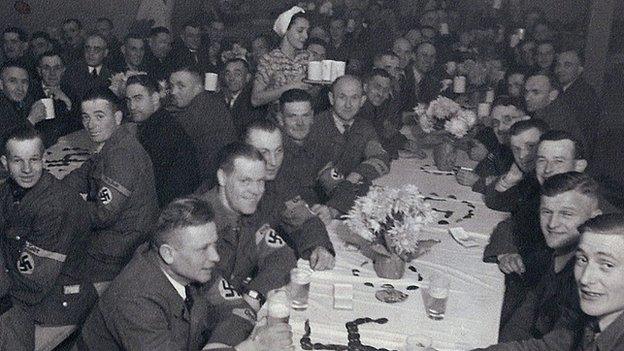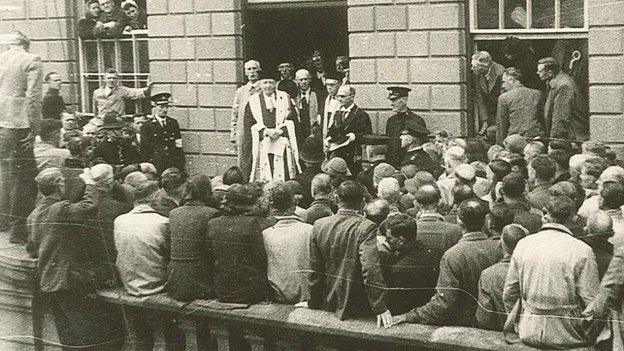Nazi victim Sidney Ashcroft's grave found after 70 years
- Published
Sidney Ashcroft was deported to a Nazi prison for stealing food and punching a German officer
By punching a German officer in Nazi-controlled Guernsey, 20-year-old Sidney Ashcroft sealed his own fate. He was trying to protect his single-parent mother but his act of resistance meant he would never see her again. Not a Guernsey native, she remained there until she died decades later - waiting in vain for her only son to return home.
Now more than 70 years on, a BBC investigation has helped unravel the mystery surrounding his disappearance and allowed Sidney's family to find his final resting place.
German armed forces ruled the Channel Islands from June 1940 until May 1945.
Sidney was one of the "Guernsey Eight" - a group of islanders who were deported to prisons and concentration camps for defying the Nazi regime.

The islands were heavily garrisoned and fortified as part of Hitler's Atlantic Wall

At the height of the occupation in May 1943, about 13,000 troops were on Guernsey and 3,800 on Alderney
Cambridge University academic Dr Gilly Carr has spent years researching the lives of this rebellious group and has retraced his final steps as part of a BBC Inside Out investigation.
"When I first saw Sidney's photograph there was something about him that's always haunted me and made me want to find out more about him; I felt he and I had unfinished business.
"When I think about Sidney my overwhelming desire is to seek justice for him."

Charlotte Ashcroft spent her life trying to find out her son's fate and did not move to the UK with her family in case he returned home
Sidney lived at home supporting his mother Charlotte Ashcroft - a single parent who had lost two daughters in infancy through ill-health.
She had a close relationship with her only son but was separated from him in 1942 after he was arrested for "serious theft and resistance to officials" and sentenced to two years and nine months' hard labour.
Archival evidence states he stole food from a German kitchen and hit a German soldier.
Dr Carr said: "Sidney's family alive today say the story in the family is that a German soldier pushed his mother which is why Sidney struck the soldier."
One day before his 21st birthday Sidney was deported to mainland Europe and incarcerated in Nazi prisons including Amberg and Diez.

Straubing prison was the last place Sidney was seen alive

He is believed to have died from tuberculosis in the prison hospital
He was last seen alive in Straubing prison, 87 miles (140km) north of Munich, two weeks before the end of the war, by fellow islander Walter Lainé.
Thousands of sick and starving prisoners were rounded up there before setting off on a forced march to Dachau concentration camp with Sidney among them.
In a letter to the War Office Mr Lainé wrote: "About 4,800 civil political and criminal prisoners were lined up in the prison yard and the director of the prison picked out the worst cases of illness, weak or most wretched looking persons. Sidney Ashcroft was with them."
Those picked out were led away, with their compatriots assuming they had been taken to be shot or gassed.
After the war Charlotte Ashcroft tried in vain to find out what happened to her son.
Despite all of her family living in her native town of Tunbridge Wells she stayed in the island, living alone until she died in 1981.
Her neighbour Maureen Cowley remembers her always talking about Sidney: "She really just spoke of him as if he was coming back next month or so, she was quite expecting him to be alive.
"If she was doing something like sweeping the cobbles or weeding a patch she'd always say 'my Sidney will do this when he comes home'."

Dr Gilly Carr has spent years researching the "Guernsey Eight" and considers them "heroes"
The mystery surrounding Sidney's fate was finally solved after a post-mortem certificate was discovered.
It said he died of tuberculosis of the lungs and larynx in the Straubing prison hospital a week after VE Day - Nazi Germany's unconditional surrender of its armed forces on 8 May 1945.
Dr Carr said: "Although the cause of death on certificates from Nazi prisons and camps cannot always be trusted, I think we can believe this report.
"TB was extremely common among the prison population and Walter [Lainé] testified that Sidney had been having throat problems which had prevented him from eating."
Dr Carr was given hope of finding Sidney's final resting place after discovering a Red Cross grave record.

Dr Carr and Chris Roberts travelled to Germany in September in the hope of finding Sidney's grave
With this crucial clue Dr Carr travelled to Germany in the hope of finding his grave. She was joined by Sidney's second cousin Chris Roberts, from Maidstone.
He said: "It's an appalling thought that Sidney just disappeared into the maw of Europe. He hadn't even reached his 21st birthday, isn't that pathetic?
"It gave me great concern that his remains were unknown and buried somewhere in Europe. I had to come and try and find him."
More than 70 years after Sidney was last seen the pair retraced his steps at the prison and the cemetery of St Michael.
The cemetery manager was able to use Dr Carr's Red Cross document to draw a map to Sidney's grave.
After combing the cemetery Dr Carr and Chris found the exact plot where Sidney was buried, beneath what is now a blank stretch of lawn.
The site is a mass grave where five bodies were thrown in at a time.

Upon finding Sidney's grave Dr Carr and Chris Roberts were overwhelmed with emotion

A memorial plaque has been laid at Sidney's grave by Chris Roberts
And so after almost 75 years of being lost, Sidney has at last been found by his family.
To mark his final resting place a memorial stone was placed at his grave by Mr Roberts.
"He's been here for 70 odd years, and really he'd been forgotten. But he hasn't been now, that's the main thing. He has a stone and people can see it."
Inside Out is on BBC One on Monday 2 November at 19:30 BST and on the iPlayer for 30 days thereafter.

- Published9 May 2015

- Published8 May 2015

- Published8 May 2015

- Published4 May 2015

- Published29 December 2014

- Published26 November 2014

- Published3 October 2014
